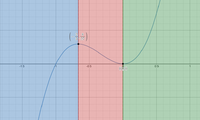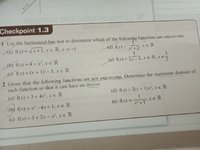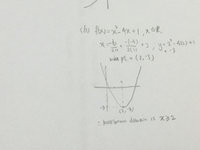You are using an out of date browser. It may not display this or other websites correctly.
You should upgrade or use an alternative browser.
You should upgrade or use an alternative browser.
How to determine maximum domain from function statements
- Thread starter mimie
- Start date
Dr.Peterson
Elite Member
- Joined
- Nov 12, 2017
- Messages
- 16,086
Can I correctly assume that you have solved 2(a)? It will be helpful to see what you did there, so we can extend it to (b).
Note that you are not asked to actually find the inverse function; that can be done for all except (d), I think, but you don't have to.
On the other hand, it will be very helpful to you if you at least sketch the graph of each function to see why they are not one-to-one, and how restricting the domain would help.
But there's a problem: unless you were given some special definition of "maximum domain", none of the problems has a unique answer. Do you have an example of the sort of answer they expect (from an example or an answer in the back)?
Note that you are not asked to actually find the inverse function; that can be done for all except (d), I think, but you don't have to.
On the other hand, it will be very helpful to you if you at least sketch the graph of each function to see why they are not one-to-one, and how restricting the domain would help.
But there's a problem: unless you were given some special definition of "maximum domain", none of the problems has a unique answer. Do you have an example of the sort of answer they expect (from an example or an answer in the back)?
- Joined
- Nov 24, 2012
- Messages
- 3,021
Yes, \(x=2\) is the axis of symmetry, so I would give as my answer that the equally sized domains are where the function is one-to-one:
[MATH](-\infty,2][/MATH]
[MATH][2,\infty)[/MATH]
I don't see why they would favor the right half over the left half.
[MATH](-\infty,2][/MATH]
[MATH][2,\infty)[/MATH]
I don't see why they would favor the right half over the left half.
Yes, \(x=2\) is the axis of symmetry, so I would give as my answer that the equally sized domains are where the function is one-to-one:
[MATH](-\infty,2][/MATH]
[MATH][2,\infty)[/MATH]
I don't see why they would favor the right half over the left half.
How about 2(d)?
- Joined
- Nov 24, 2012
- Messages
- 3,021
How about 2(d)?
Unless you are familiar with techniques in differential calculus for determining the turning points (since you posted in the Pre-Algebra forum I am assuming you have not studied the calculus yet), you'll have to rely on a graph of the function:

I have labeled the turning points, and shaded the 3 domains on which the function is one-to-one. They are:
[MATH]\left(-\infty,-\frac{2}{3}\right][/MATH]
[MATH]\left[-\frac{2}{3},0\right][/MATH]
[MATH][0,\infty)[/MATH]


